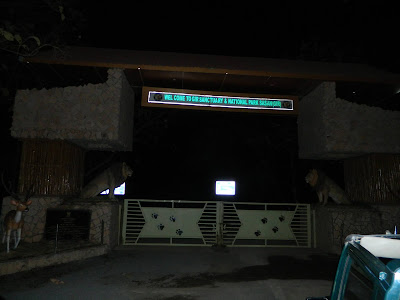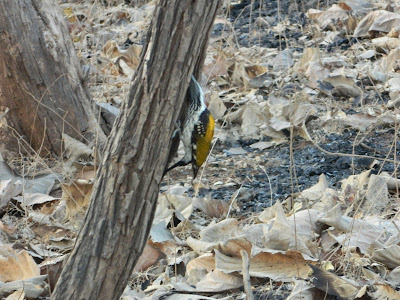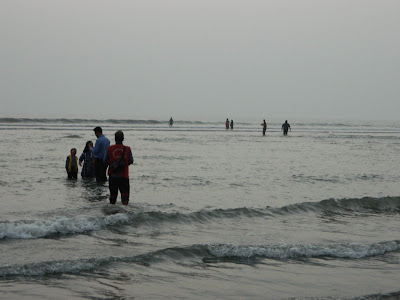The bus of Himachal Tourism Development Corporation left Manali
bus depot exactly at six o’clock in the morning. The bus had a capacity of
twenty-seven passengers out of which fourteen were Indians and the rest foreigners
from different countries.
Though it was August, yet morning temperature was hovering between
six and eight-degree census. Because of the early morning hangover, we could
not have breakfast and carried dried consumables as nothing would be available
on road.
First Day Journey
Since it was a trip with two friends; it was a formality to inform
the family about our departure as the network would be absent after leaving
Marhi. The journey was long covering a distance of 472 km from Manali to Leh
and the bus would not provide any unscheduled stop except emergency.
The bus took a sharp bent crossing Vasisth Kund and the valley on
the left side was found to be covered with white snow. The traces of
unprecedented rain on the previous night at Manali had remained in form of snow
on the higher altitude.
The beauty of Rohtang Pass was simply amazing. It
was totally white, without any sign of the presence of rocks of the Pir Panjal
range of Himalayas. We were at the height of 3980 meters after travelling almost
51 km from Manali. The tourists arriving at Rohtang Pass could not be seen as
it was too early and the vehicle smoothly got down to Gramphoo without any
traffic jam in Rohtang Top.
There was a diversion at Gramphoo which led to Kaza, headquarters
of Spiti district. We continued on the main road leading to Khoksar and to
Keylong, headquarters of Lahul district.
The road was gradually becoming undulated with sharp bends and at
times crossing gushing water flows coming down from the mountains.
Meanwhile, we crossed Tandi, the confluence of
Chandra river flowing from Chandratal Lake and Bhaga river flowing from Suraj Tal Lake and the unified river was named as Chandrabhaga or Chenab.
Incidentally, the last petrol pump of Himachal Pradesh on the
Manali-Leh Highway was stationed at Tandi. There was a warning signal from the
National Highway Authority of India to fill up the tanks of vehicles as the
next refilling station would be available after 350 km.
We were continuously following an SUV keeping a safe distance
right from Manali. As we were about to reach Keylong, the driver made an abrupt
stop with a huge jerk. We were really scared as the majority of the passengers
were dozing. We found a huge boulder dropped from mountains rolling down on the
road and again falling from the cliffside of the road. It was really a narrow escape.
Lunch Break at Keylong
With the grace of almighty, we somehow reached Keylong for
our lunch break at Himachal Pradesh Tourism Development Corporation (HPTDC)
hotel and there was a break for around one hour.
We had already travelled 116 km by that time. After lunch, the
vehicle started at around half past one noon and soon we reached two villages
called Jispa and Darcha. There were hotels and homestays in both the villages
being the border of Himachal Pradesh and Jammu & Kashmir.
Soon we crossed the border through a suspension bridge constructed
by the Indian army. On the way, we came across Deepak Tal, a small lake
followed by great Suraj Tal which was the source of the Bhaga river. Due to our
request, the driver made a photo stop for a few minutes and few passengers
offloaded the extra fluid from their stomach during that halt.
The entire landscape showed a drastic change after crossing Suraj
Tal. The greenery had vanished and every turn in the meandering road
depicted a change of colour of the mountains. The vehicle was moving towards
elevation with a huge sound protesting against the pressure on the accelerator.
We learnt that we were crossing Baralacha La or
Baralacha Pass which was at the height of 4980 meters or more than 14000 feet
above sea level.
There was a change in the driving seat after our stop at Keylong. We reached the highest point of Baralacha Pass where a temple was constructed with loose stones decorated with the Tibetian flags. We had the second halt for clicking photographs of the pass.
Gusty wind dashing against our body forced us to return to the
vehicle and the next part of the downward journey started towards Sarchu, where
we were supposed to take a halt for the night.
Camping at Sarchu
At around 04.30 in the afternoon, we reached our day’s
destination Sarchu. It was a plain land of few acres, where around
eight tents were constructed accommodating thirty-two persons, with few
makeshift washrooms at one end of the camping ground. Each tent could
accommodate four persons and since we were three, we found the extra bed
remained empty.
There was a rippling stream at one side of the camping ground
which was the only source of water for the tents. A diesel-generated pump was
placed to fill up four tanks installed on a height for smooth flow of water to
washroom and kitchen. Packaged water was supplied for the consumption of
tourists.
Tea and light snacks were served followed by dinner at around
seven o’clock in the evening. By that time, it was pitch dark outside. Few
solar lights were planted on poles to show our path. The temperature was too
cold to remain outside, but we did not miss a rare chance to see millions of
bright glittering stars above our heads. It seemed that we were also in space
and the galaxy was staring at us.
Second Day Journey
The journey on the next day started exactly at 06.30 hrs in the morning after breakfast.
Incidentally, the bus ticket included our lodging, food, and
beverages at Sarchu camp as nothing was available outside. We had to pay for
our lunch at Keylong and future payment would also have to be made by us.
Soon we came across Gata Loops, with continuous hairpin bends in
the mountains at a height of 4190 meters and the driver remained extremely alert
on the entire belt because of upcoming vehicles and falling boulders.
Though we were enjoying the ultimate beauty of the road, our
subconscious mind was scared as we were not accustomed to seeing the
perpendicular cliffs continuously in that stretch of road.
Meanwhile, we crossed two consecutive passes, Nakee La and Lachulung
La with heights of 4740 meters and 5079 meters respectively.
Hopefully, by that time we had become used to the crossing of passes with dry
mountains on one side and deep cliffs on another side. The vehicle was moving
at a maximum speed of 20 km per hour because of continuous uphill and downhill
bends.
The road was very narrow with very little space for two vehicles
to cross each other. Of course, rarely vehicles were coming from the opposite
side and if so, each vehicle had to be dead slow to cross each other.
Having crossed the rugged terrain since the previous day, we
reached an absolutely plain land for miles together with mountains on both
sides at quite a distance. The plain was absolutely dry with a lunar landscape.
We could see bushes and grasses after long intervals.
The habitats of the area were marmots, an animal looking like
squirrels of a bigger size. They resided in holes in the surface and found
raising their heads and hiding again when vehicles approached nearer. A group
of wild asses was also seen, far away, grazing in the plain. Otherwise, there
was no sign of living creatures in the entire plain.
At around 12 noon, we reached a place called Pung, which
was also in the same stretch of plain land where few tents were planted. We had
a sigh of relief after having seen human beings in such a deserted area. The
tents were actually restaurants temporarily established to cater to the
tourists with lunch and other consumables. Few tents were allocated for rest
and even night stay for travellers especially bikers plying between Manali and
Leh.
It was not a luxurious lunch but more of a combination of Indian,
Continental, and Tibetian cuisine. Cold and hot beverages were also available
along with packaged food and water.
After lunch, we continued our journey through the plains and it
seemed that there was no ending to it. The vehicle was moving at its highest
speed as there was no hindrance and visibility was at its height.
After we crossed a place called Debring, the mountains started
approaching nearer and we were ready to cross the highest pass of the
route Tanglang La, with the highest point at 5238 meters.
Though the roads were of the same type as other passes we crossed,
yet our mental strength had increased by that time and we enjoyed the beauty of
the mountains.
The mountain range took a typical shape in that region. We learnt
that the force of the wind had created gaps and bends in such a fashion, the
entire range looked like forts with variations of colours of the soil.
After crossing Tanglang La, we came down to a land which was
totally filled with greenery and the total topographical feature changed in a
moment. The place was known as Upsi. We could see, the famous
Indus river had joined us on our journey and it would be guiding us to Leh.
The habitats of this region had undertaken agriculture and allied
activities and we could see fields with crops, sporadic grazing of animals, and
movement of human beings.
The undulated rough terrain had vanished and we started moving with
Indus, our partner. The road was smooth and we could see an increase in the
number of dwelling houses, fields with crops, and pieces of evidence of
habitation.
At around five o’clock in the evening, we crossed Thiksey
Monastery and few other monasteries and entered the main bus stand of Leh.
We thanked our drivers for carrying us such a long journey with
treacherous roads and mountain passes without any hindrance.
Modes of Travel
The buses between Manali and Leh can be booked from HPTDC offices.
Private vehicles with J & K permit also ply with a halt at Keylong or
Sarchu. Few vehicles also complete the journey of 472 km in one day but that
becomes strenuous and the tourists are not able to enjoy the journey to the
desired level.
Boarding & Lodging
Arrangements for boarding and lodging at Manali and Leh are in
abundance. The tourists can book hotels as per their choice and budget.
Lodging at tents in Sarchu and Pung are only with basic
necessities but costlier than normal stay. The availability of food is limited
and travellers can carry dry consumables if required.
My experience
The journey can be described in one word as “Incredible”. The
change of landscapes, the experience of staying in tents in a deserted place,
and the view of the lunar landscape was simply amazing. The frightening roads
through passes above 10000 feet were totally a new perception that cannot be
missed.
Though our return journey from Leh to Srinagar was by road, the fearful enjoyment we received during our travel from Manali to Leh will be
in the permanent storage of my memory.
Photo Courtesy: Google






























